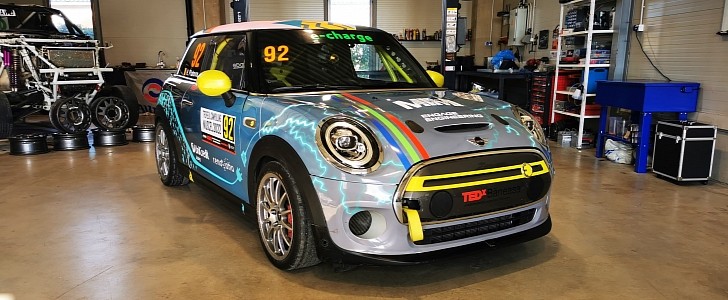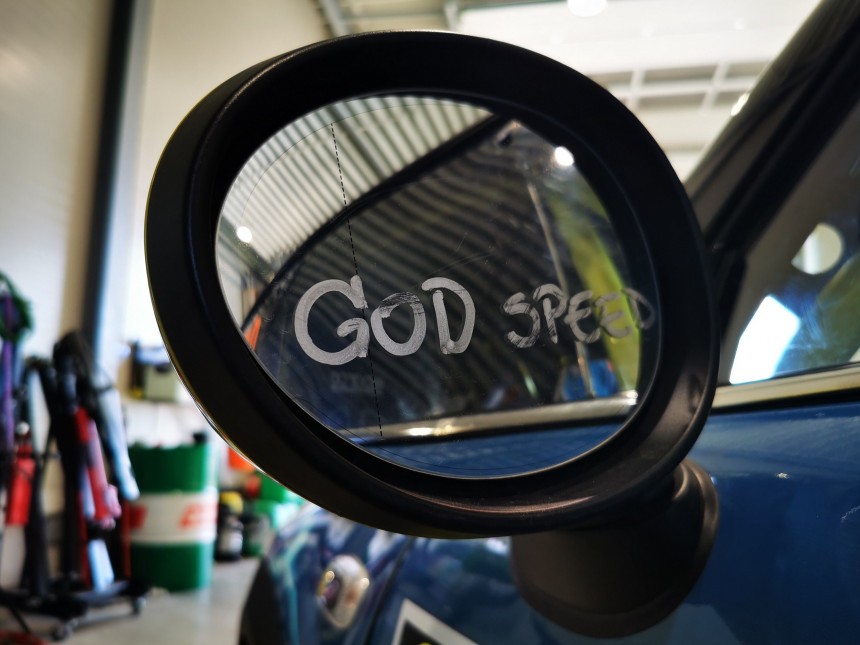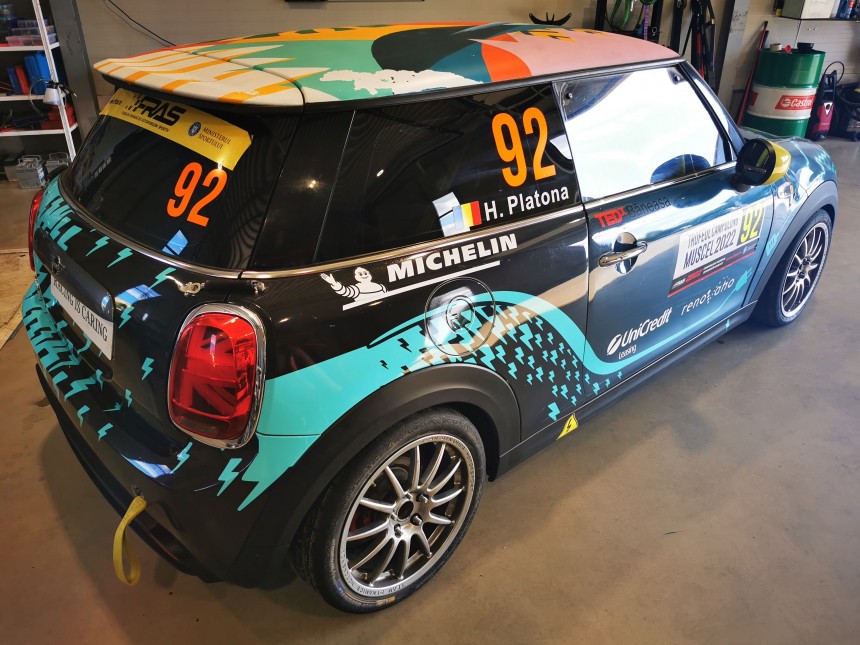Unbeknownst to many, MINI’s first all-electric racer is nicknamed MIMI. It appeared in a small European country thanks to a collective effort and mostly due to a couple of very stubborn people. After it was put to the test several times on different tracks, the two-door zero-tailpipe emission was upgraded and turned into MIMI EVO. Now, it’s nearing its completion. Here’s a story that proves perseverance is not overrated in today’s world.
Back in 2010, the MINI E was embarking on a pioneering journey. It started life as a prototype, created by the manufacturer only to test how the all-electric powertrain would fare in multiple environments. With its 200 HP (203 PS), a 35-kWh battery, and an estimated range of about 100 mi (162 km), the little car managed to reach an impressive feat – the MINI E became the first EV to establish a record on the famous Nürburgring-Nordschleife.
Nine years later, the British automotive brand owned by BMW finally went through with it and gave the world the first zero-tailpipe emission MINI – the 2020 Cooper SE. It was received pretty enthusiastically, considering only a month was necessary for over 45,000 reservations to be registered.
Approximately two years ago, autoevolution was learning about a 181-HP (184-PS) MINI Cooper SE used mainly for all kinds of testing purposes that escaped a doomed fate. Usually, these cars are sacrificed by engineers to uncover useful data and then they’re scrapped. But this particular 2020 MINI Cooper SE managed to live on. The effort was spearheaded by one of BMW’s Communication Manager named Alex Seremet. Afterward, partners like Michelin, Vitesco (formerly under Continental ownership), or big dealerships hopped on board.
The first changes were timid. The people involved in the project started to work on the brakes, the suspension, and the thermal management system. Weight reduction was also an important concern and the discussions around cooling kept going back and forth. However, things kept happening for the all-electric model. It was the start of an amazing journey.
autoevolution met with MIMI EVO back in March. We discovered it at the beginning of a new season of racing. Now, six months later, we get to see it again after a busy season of changes and improvements.
On the way to the shop that now takes care of everything the car needs to be done to it, I got to experience the all-new 306-HP (310-PS) 2022 MINI Clubman John Cooper Works. Admittedly, it was a tad bit anticlimactic to drive a gas-powered station wagon to rediscover the all-electric race-ready hatchback. However, the turbocharged four-cylinder power unit felt amazing at any point of the journey.
Driving the Clubman is like meeting with an old friend. It’s supportive and familiar, yet you trust it enough to continue pushing until all barriers are broken. It’s easy to get accustomed to it. The fact that it has four doors and a decent-sized trunk makes it even more alluring. The best thing? Well, it does not attract everyone’s attention and remains sort of a pocket rocket. Keep in mind this is just an impression. I haven’t had the time to properly discover it.
The Clubman brought me safe and sound to the place where the salvaged EV racer is now resting and getting ready for all kinds of future events. It’s a tiny shop in a county from the Romanian region of Transylvania. I did not expect to see such a simple place. It looked like someone’s startup, but it felt like it was filled with incredible stories. It exuded confidence and passion.
All this allowed the car to reach a top speed of 124 mph (200 kph) and a zero-to-60 time of just six seconds – one second less than what the car was originally capable of.
Thermal management was also a worry because of the intense drives. So, to not add ventilators or liquids that could impact the performance, the team that now continues to work on the car made use of dry ice.
The engineers and technicians also sourced a John Cooper Works braking system, added some carbon fiber bits, and changed the differential. There have also been installed special hydraulic racing brake pumps that allow for better front-rear weight distribution.
One important win for the project was the creation of a tuning solution that can now be ordered by any BMW i3/i3s or MINI Cooper SE owner for improved performance - the Drexler limited slip front differential.
MIMI’s current year ends with a total of 18 national races and multiple participations at international events. Most of the latest positive outcomes happened thanks to Engage Engineering founder Horia Platona. Besides working on it, he also got in the driver’s seat for races or other events.
Platona told autoevolution that he was impressed with the vehicle from the very beginning. It showed an unexpected level of resilience and, after figuring out the complicated programming, he and his team now know how to play with the software to make the car respond as best as it can under any circumstances.
One remarkable thing is that MIMI was able to have an incredibly busy schedule, with races and events almost weekly and needed no special maintenance. This is a huge benefit when comparing the EV with an internal combustion equivalent vehicle.
The complete pack of changes is worth about $19,490 (€20,000). Now, it’s a tad bit complicated to argue in favor of it considering the starting price of the new MINI Cooper SE is $34,225 in the U.S. However, these changes would allow your EV to keep up on the track with the likes of Tesla Model 3 on winding slalom tracks.
Lastly, there is a place where you can transform your two-door vehicle that provides a guilt-free go-kart experience – Engage Engineering, in Brasov, Romania. And it exists solely thanks to those that never dared to stop dreaming and aiming high!
Nine years later, the British automotive brand owned by BMW finally went through with it and gave the world the first zero-tailpipe emission MINI – the 2020 Cooper SE. It was received pretty enthusiastically, considering only a month was necessary for over 45,000 reservations to be registered.
Approximately two years ago, autoevolution was learning about a 181-HP (184-PS) MINI Cooper SE used mainly for all kinds of testing purposes that escaped a doomed fate. Usually, these cars are sacrificed by engineers to uncover useful data and then they’re scrapped. But this particular 2020 MINI Cooper SE managed to live on. The effort was spearheaded by one of BMW’s Communication Manager named Alex Seremet. Afterward, partners like Michelin, Vitesco (formerly under Continental ownership), or big dealerships hopped on board.
The first changes were timid. The people involved in the project started to work on the brakes, the suspension, and the thermal management system. Weight reduction was also an important concern and the discussions around cooling kept going back and forth. However, things kept happening for the all-electric model. It was the start of an amazing journey.
Growing pains can lead to enhanced creativity and flexibility
In 2021, MINI launched the Formula E Safety Car in the shape of the Electric Pacesetter inspired by JCW. Two months later, the MINI E prototype was sitting side by side with the facelifted MINI Cooper SE. Meanwhile, in the Eastern European country of Romania, MINI’s first all-electric racer continued to evolve. The small Romanian race workshop Engage Engineering joined the project late last year. Progress happened quickly! Just three months ago, the vehicle was registering a 30-second improvement at a race it ran in 2021 and this year. Now, MIMI has new partners like Renovation and Unicredit Leasing. Michelin remained onboard along the way.autoevolution met with MIMI EVO back in March. We discovered it at the beginning of a new season of racing. Now, six months later, we get to see it again after a busy season of changes and improvements.
On the way to the shop that now takes care of everything the car needs to be done to it, I got to experience the all-new 306-HP (310-PS) 2022 MINI Clubman John Cooper Works. Admittedly, it was a tad bit anticlimactic to drive a gas-powered station wagon to rediscover the all-electric race-ready hatchback. However, the turbocharged four-cylinder power unit felt amazing at any point of the journey.
Driving the Clubman is like meeting with an old friend. It’s supportive and familiar, yet you trust it enough to continue pushing until all barriers are broken. It’s easy to get accustomed to it. The fact that it has four doors and a decent-sized trunk makes it even more alluring. The best thing? Well, it does not attract everyone’s attention and remains sort of a pocket rocket. Keep in mind this is just an impression. I haven’t had the time to properly discover it.
Making headway
In this peculiar garage that almost made me feel like I was witnessing the first moments of something that’s poised for greatness, I found out the EV went through many modifications. And, most of them, were done after intense testing and a lot of trial-and-error procedures. For example, the car now weighs 2,645 lb (1,200 kg) with no changes done to the battery. It’s all thanks to a cabin overhaul and many clever tricks that allowed for the replacement of glass panels with lightweight plexiglass. Similarly, the car’s body was modified to be as light as possible without compromising on body strength.All this allowed the car to reach a top speed of 124 mph (200 kph) and a zero-to-60 time of just six seconds – one second less than what the car was originally capable of.
Thermal management was also a worry because of the intense drives. So, to not add ventilators or liquids that could impact the performance, the team that now continues to work on the car made use of dry ice.
The engineers and technicians also sourced a John Cooper Works braking system, added some carbon fiber bits, and changed the differential. There have also been installed special hydraulic racing brake pumps that allow for better front-rear weight distribution.
One important win for the project was the creation of a tuning solution that can now be ordered by any BMW i3/i3s or MINI Cooper SE owner for improved performance - the Drexler limited slip front differential.
Platona told autoevolution that he was impressed with the vehicle from the very beginning. It showed an unexpected level of resilience and, after figuring out the complicated programming, he and his team now know how to play with the software to make the car respond as best as it can under any circumstances.
One remarkable thing is that MIMI was able to have an incredibly busy schedule, with races and events almost weekly and needed no special maintenance. This is a huge benefit when comparing the EV with an internal combustion equivalent vehicle.
The complete pack of changes is worth about $19,490 (€20,000). Now, it’s a tad bit complicated to argue in favor of it considering the starting price of the new MINI Cooper SE is $34,225 in the U.S. However, these changes would allow your EV to keep up on the track with the likes of Tesla Model 3 on winding slalom tracks.
Lastly, there is a place where you can transform your two-door vehicle that provides a guilt-free go-kart experience – Engage Engineering, in Brasov, Romania. And it exists solely thanks to those that never dared to stop dreaming and aiming high!

















